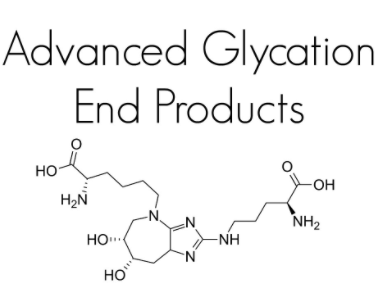
Advanced glycation end products (AGEs) are a large and mixed group of compounds that originate from the reaction between sugars and various lipids (fats), proteins, or free amino groups in amino acids that undergo a chemical reaction (glycation) as a result of chronic exposure to glucose or other reducing sugars. AGEs accumulate in long-lived proteins such as collagen (hence why we look so much older and have gut issues) and have been indicated as components of oxidative stress generation in tissues. AGEs induce the damage by 2 main mechanisms. First, AGEs may crosslink proteins, directly altering their structure and therefore their properties and function. Second, AGEs activate intracellular signals which lead to increased inflammation.
AGE formation and accumulation are linked with all types of chronic illness and metabolic diseases such as diabetes mellitus and physiologic changes such as aging. Studies have reported that AGEs are involved in the incidence and progression of age-related chronic diseases, such as cardiovascular disease, heart failure, chronic kidney disease, and dementia and other neurodegenerative diseases. AGEs have also been associated with causing ocular diseases, such as cataract, diabetic retinopathy, age-related macular degeneration and glaucoma
However, it is not just the processed carbohydrates and sugar that are the problem. Over the past 2 decades there has been increasing evidence supporting an important contribution from food-derived advanced glycation end products (AGEs) to the body pool of AGEs and therefore increased oxidative stress and inflammation. Increasing evidence points to exogenous AGEs (derived mostly from food and tobacco) as important contributors to the body’s AGE pool, where they become indistinguishable from endogenous (internally produced) AGEs, both in structure and function.
Not just the foods but different cooking methods can substantially affect the AGE content of food without necessarily changing the nutrient composition. For example, using the same amount of chicken, but treating it with different cooking methods for the same length of time, will produce very different AGE content. In general, animal-derived foods cooked at a high temperature for a prolonged period of time and under dry conditions will have the highest AGE content.
Knowledge about the factors determining the amount of AGEs in foods allows us to use culinary techniques that reduce food AGE content without necessarily changing the type and quantity of foods consumed. The essential concept when introducing a low AGE diet is that it is the manner of cooking, not the actual nutrient composition of the food, that determines its AGE content. For example, stewing or steam-cooking meat, which maintains food moisture during cooking, will generate much less AGE than broiling or frying. Marinating will also have an AGE-reducing effect by lowering the local pH of food (pH effect of lemon or vinegar).
Many phytochemicals and their nutrients have been tested for their ability to prevent AGE formation. Polyphenols (phenolic acids, flavonoids, and stilbenes) derived from both medicinal and food plants constitute the major group of compounds that have demonstrated the ability to prevent AGE formation.
Sources:
Adv Nutr. 2015 Jul; 6(4): 461–473. Dietary Advanced Glycation End Products and Their Role in Health and Disease1,2Jaime Uribarri,3,* María Dolores del Castillo,4 María Pía de la Maza,5 Rosana Filip,6 Alejandro Gugliucci,7 Claudia Luevano-Contreras,8 Maciste H Macías-Cervantes,8 Deborah H Markowicz Bastos,9 Alejandra Medrano,10 Teresita Menini,7 Manuel Portero-Otin,11 Armando Rojas,12 Geni Rodrigues Sampaio,9 Kazimierz Wrobel,13 Katarzyna Wrobel,13 and Ma Eugenia Garay-Sevilla8 doi: 10.3945/an.115.008433 PMCID: PMC4496742 PMID: 26178030
J Am Diet Assoc. 2010 Jun; 110(6): 911–16.e12. doi: 10.1016/j.jada.2010.03.018. Advanced Glycation End Products in Foods and a Practical Guide to Their Reduction in the Diet. JAIME URIBARRI, MD, SANDRA WOODRUFF, RD, SUSAN GOODMAN, RD, WEIJING CAI, MD, XUE CHEN, MD, RENATA PYZIK, MA, MS, ANGIE YONG, MPH, GARY E. STRIKER, MD, and HELEN VLASSARA, MD